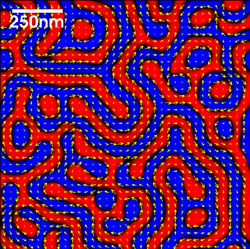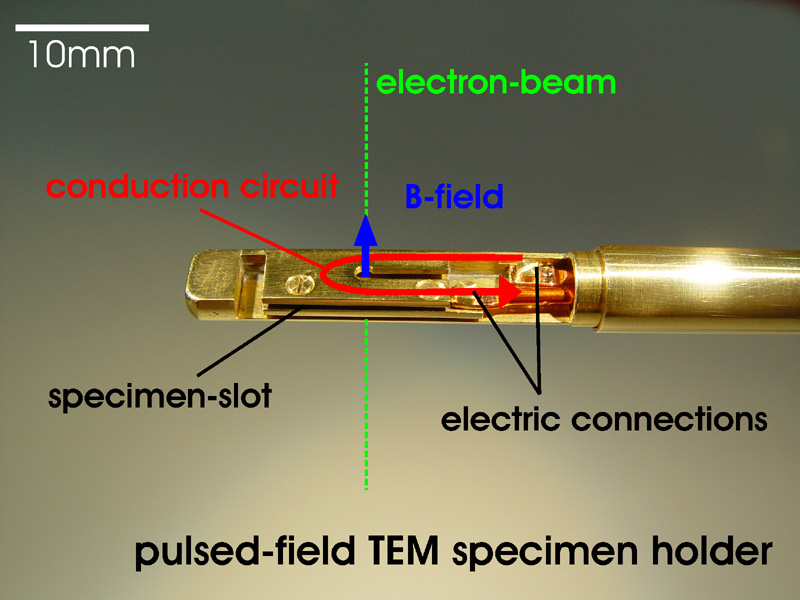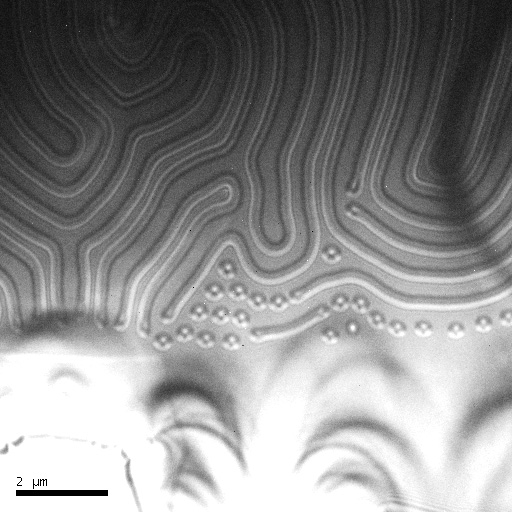
|

| |
|
|
| |
Preparation and characterisation of magnetic specimens
for CHIRALTEM purposes
- In the context of the CHIRALTEM project, we prepare and investigate
magnetic specimen which are expected to be suitable for the measurement
of a circular dichroic-like interaction between the electron beam
and the specimen in a TEM (transmission electron microscope).
In the moment, we work on cobalt monocrystals with a very high saturation
induction of about Ms=1.8 T and on iron garnet films with only approximately
150 mT of saturation induction. Both specimens show a perpendicular
anisotropy, due to which the magnetisation in the specimen is oriented
mainly out of plane.
|
|
| Lorentz electron micrograph
of a thin YIG film with perpendicular field of 0.05T |
|
- Due to the low saturation field, the magnetisation
of the garnet specimen will always be saturated in the magnetic
field of the regular objective lens of the TEM when operated
in High Magnifiaction modes, i.e. above approx. 5 kX. if the
current through the objective lens is reversed this causes
also a reversal of the magnetic field of the lens, followed
by switching of the magnetization direction. This inturn would
lead to a measurable change in the dichroic effect. Below
a picture of a garnet film in a magnetic field of only 0.05T
can be seen. The stripe domains are already breaking up into
magnetic bubbles. If the magnetic field gets higher, the specimen
will be magnetised completely out of plane along the external
field direction.
|
dynamic of garnet domains:
download movie (14MB)
|
- In contrast to that, the high saturation
field of a cobalt monocrystal might make it possible to observe
magnetic domains under certain conditions, although the objective
lens is activated. A small shift of the electron beam from
one domain to another would then change the magnetisation
seen by the electrons and should also lead to an easily measurable
dichroic effect.
|
|
|
| Lorentz electron micrograph of a
thin cobalt film without external field |
|
 |
| LLG-simulation of cobalt
domains |
|
- Micromagnetic simulations will
supplement our experiments. Here an
LLG-simulation
of a thin cobalt film (50nm) is shown. The dimension is 1.28µm
x 1.28µm . Red and blue colors indicate the magnetisation
pointing into and out of the specimen plane. The yellow arrows
indicate the in-plane component of the magnetisation in a plane
located at a depth z/2 in the specimen, where z is the thickness
of the thin specimen.. Obviously, there are large neighbouring
areas of alternatingly up and down oriented magnetic induction,
which will allow the change from one magnetic orientation within
the specimen by simply shifting the beam from one area to another
without changing other parameters such as specimen thickness,
lens excitation, specimen height etc. which might influence
the measurement. |
|
|
| |
- For further investigations, we construct a pulsed-field
TEM specimen holder which will enable us to apply magnetic fields
of more than 0.5T for short times (ms). It might also be used for
a variation of the magnetic field perpendicular to the specimen
if used with permanent current. Its main purpose, however, is tocause
a remanent change of magnetic domains if used with pulsed currents.
A sketch of this specimen holder is shown below.

Pulsed-field specimen
holder for TEM
|
|
|





